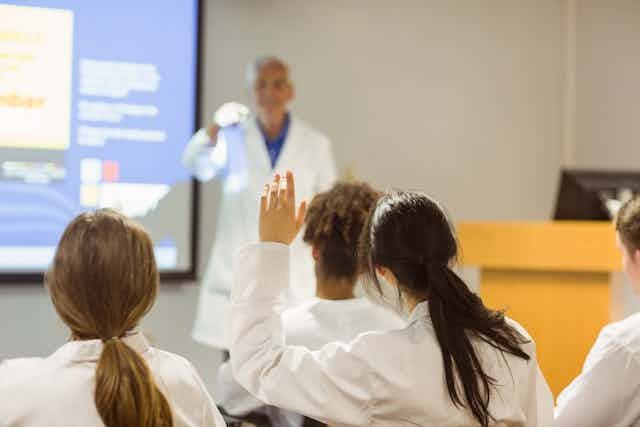Chronic conditions, such as Type II diabetes and hypertension, account for seven in 10 deaths in the United States each year. And by some estimates, public health factors, such as the physical environment we live in, socioeconomic status and ability to access health services, determine 90% of our health. Biomedical sciences and actual medical care – the stuff doctors do – determine the remaining 10%.
Clinical medicine can treat patients when they are sick, but public health provides an opportunity to prevent disease and poor health. But too often, medical students don’t get to learn about public health, or how to use it when they become doctors. That means many of today’s students aren’t learning about health care in a broader context.
Why doctors need to know about public health
What should a physician do if patients are unable to visit a physician because their workplace doesn’t give them sick days? What about an obese individual who has trouble following healthy eating recommendations because their neighborhood doesn’t have a grocery store?
If we want the next generation of medical professionals to understand why some patients have an easier time following a care plan than others, or understand what causes these conditions so we can prevent them, medical schools need to look toward public health.
Epidemiology, a core discipline within public health, emphasizes the study and application of treatment to disease and other health-related issues within a population. It is focused on prevention, which means understanding what makes people sick or unwell.
You might hear about epidemiologists who work on figuring out how infectious diseases spread. But they also study obesity, cancer, how our environments affect our health and more.
So a doctor with training in public health would have an understanding of how environmental, social and behavioral factors impact their patients’ health. These physicians might also draw on other medical professionals to treat individuals who are sick, and prevent sickness from occurring in the first place.
Medical schools recognize that their students should learn more about public health. But according to the Association of American Medical Colleges (AAMC), about one-fourth of 2015 medical school graduates report that they intend to participate in public health-related activities during their career, and nearly one-third of graduates report that training related to community health and social service agencies was inadequate.
Putting public health into medicine
But this is slowly starting to change.
For instance, the Medical College Acceptance Test (MCAT), which all medical school applicants in the US take, used to focus on just physical and biological sciences and verbal reasoning. But in 2014 the MCAT added a new section on the psychological, social and biological foundations of behavior. The idea is to provide students with a foundation learn about what public health scholars call the social determinants of health. These are conditions and environments in which we are born, work, live and interact with others.

Expectations for students transitioning from medical school to their postgraduate residency are also starting to change.
The AAMC has a list of 13 activities that medical school graduates are expected to be able to do on their first day of residency. The activities (called Entrustable Professional Activities, or EPAs) integrate, among other core competencies, principles of public health into everyday practice. They include guidelines for working with individuals who have different belief systems, patient-centered practice and understanding how to access and use information about the needs individuals have and the community resource available to them.
Having students make house calls
At the University of Florida, where I teach, population health-based topics are integrated into our medical school curriculum, and also into curricula for other health professions.
Each fall, 700 first-year health science students studying everything from dentistry to clinical psychology, health administration, pharmacy, nursing and more take part in a service learning project with local families.
Students complete coursework about public health, but they are also assigned to work with a family through the year. Students make a series of home visits, which means that they can see, firsthand, how the family’s home environment shapes their health. Because the project includes students from all the health professions, it helps them understand each other’s roles and responsibilities in providing care.
In these visits, students get a chance to see the myriad factors that can make it easier or harder for a patient to follow the care plan their doctor prescribes. Students may learn that their patients have priorities in life that come before monitoring their own health. And for many students, this may be the only home visit that they make during their entire career.
For instance, a team of our students were humbled to learn that one of the patients they visited, a woman with severe hypertension and Type II diabetes, put her desire to provide Christmas presents for the six grandchildren she was raising over her medication adherence or her glucose monitoring. She was more focused on her grandchildren than spending time on monitoring her health and taking medications.
These home visits show students how complex their patients’ lives really are. And that give these future doctors a perspective on their patients that they may never get in a clinical visit.
Other medical schools putting public health on the agenda
The University of Florida isn’t the only medical school investing time and energy to explore new methods to teach students about public health.
Some are adopting dual-degree models that allow medical students to earn degrees in both public health and medicine. Often, these programs extend students’ training by 12 months, but some institutions, like the University of Miami and the University of Texas Health Science Center at San Antonio, have developed four-year dual-degree programs.
Other institutions, such as the University of Illinois and Florida International University, are integrating population and public health perspectives throughout their curricula, to make sure that all students learn about public health.

